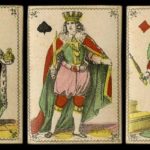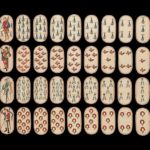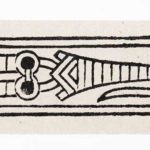French suited playing cards or French-suited cards are cards that use the French suits of trèfles (clovers or clubs ♣), carreaux (tiles or diamonds ♦), cœurs (hearts ♥), and piques (pikes or spades ♠). Each suit contains three face cards: the valet (knave or jack), the dame (lady or queen), and the roi (king). Aside from these aspects, decks can include a wide variety of regional and national patterns, which often have different deck sizes. In comparison to Spanish, Italian, German, and Swiss playing cards, French cards are the most widespread due to the geopolitical, commercial, and cultural influence of France, the United Kingdom, and the United States in the 19th and 20th centuries. Other reasons for their popularity were the simplicity of the suit insignia, which simplifies mass production, and the popularity of whist and contract bridge. Reference: Wikipedia
Below are some examples and price guides of antique, French playing cards including a miniature set of hand colored cards and a playing card box
Cards with French suits: complete pack of 40 playing-cards, for the game of Solo: Brocade cards Hand-painted and inlaid with coloured fabrics Backs mottled red 18th Century
Reference: © The Trustees of the British Museum
A FRENCH ART NOUVEAU MARQUETRY PLAYING-CARD BOX IN THE MANNER OF LOUIS MAJORELLE, CIRCA 1900 The top with a marquetry landscape scene of swans in a pond, fitted with bone counters and sets of 19th Century French playing cards 13 in. (33 cm.) wide
Sold for GBP 1,000 at Christie’s in 2011
Miniature Hand-Colored Playing Cards. French [?], ca. 1851. 52+OB. Each of the courts bearing fine miniature engraved images of Kings, Queens, and Jacks, with hand-coloring. Cards 2 1/8 x 1 ½”. Housed in an elaborate miniature gilt metal and patterned cloth box with hinged lid, approximating the appearance of a miniature book. With internal folding paper wrapper and matching slipcase, the case stamped in gilt with the year 1851 on one panel
Sold for $500 at Potter & Potter Auctions in 2021
The Cloisters Playing Cards ca. 1475–80 South Netherlandish
The Cloisters set of fifty-two cards constitutes the only known complete deck of illuminated ordinary playing cards (as opposed to tarot cards) from the fifteenth century. There are four suits, each consisting of a king, queen, knave, and ten pip cards. The suit symbols, based on equipment associated with the hunt, are hunting horns, dog collars, hound tethers, and game nooses. The value of the pip cards is indicated by appropriate repetitions of the suit symbol. The figures, which appear to be based on Franco-Flemish models, were drawn in a bold, free, and engaging, if somewhat unrefined, hand. Their exaggerated and sometimes anachronistic costumes suggest a lampoon of extravagant Burgundian court fashions.
Reference: The Metropolitan Museum of Art
Playing cards–Transformation pack of Schiller’s “Jeanne d’Arc” TÜBINGEN: J.G. COTTA, 1805 52 cards, each 96 x 69mm., stipple engraved, some hand-coloured, the court cards containing characters from Schiller’s play, captions in French, blank versos, 13 mounted in a frame, the rest in a folder attached to the back of the frame
Sold for 2,250 GBP at Sotheby’s in 2013
Uncut sheet of playing cards coloured by hand. With eight cards with four queens and four kings. On the top row are the queen of clubs(?), the king of diamonds, the queen of diamonds, a king (no suit sign). On the lower row are a king (no suit sign), the queen of hearts, the king of hearts and the queen of clubs(?).
An early use of the woodcut technique was for making playing cards. The oldest surviving examples date to about 1420. This sheet is thought to have been made by an artist called F. Durand in Rouen or Lyons in the first half of the 16th century. Woodcuts allowed multiple copies of an image to be printed relatively cheaply and quickly. This sheet shows how cards were printed for speed and economy, many to a sheet and cut into individual cards afterwards.
Reference: © Victoria and Albert Museum







